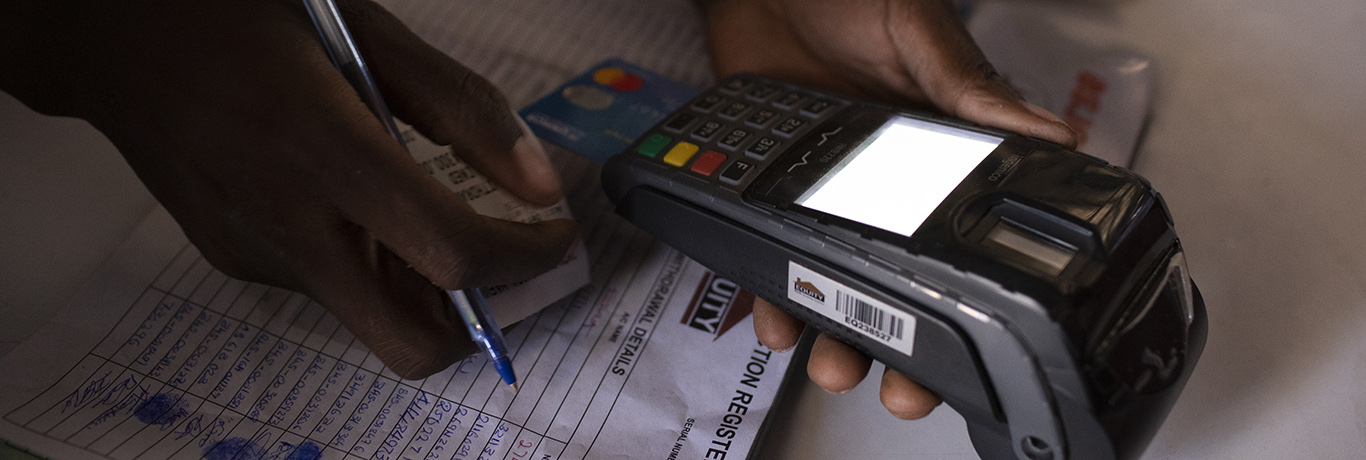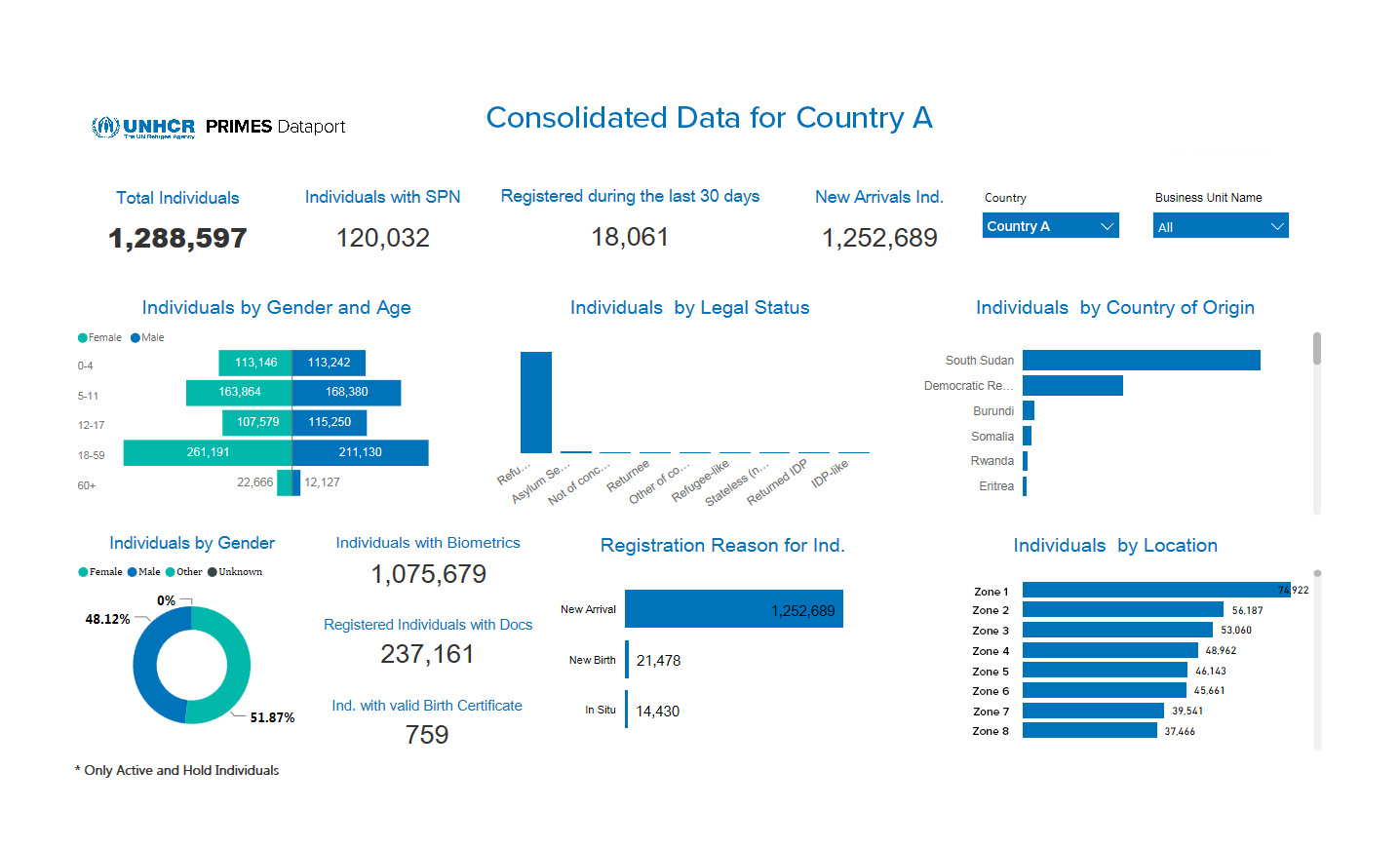The below examples demonstrate how registration data, together with other data stored in PRIMES, can meaningfully inform programming.
Conversely, delayed or insufficient attention and analysis of registration data can lead to critical protection gaps on the ground, seriously impacting UNHCR’s preparedness, negotiating position with the host government as well as resource capacity to respond to urgent protection needs.
Example: Consider an emergency context, with new arrivals crossing the border and needing emergency shelter and assistance. If the rate of arrivals is not correctly identified through available information including registration data, a host of negative consequences for persons of concern may follow, including, for example:
- UNHCR is ill-equipped to negotiate with the host government on land allocation for settlements, potentially leaving tens of thousands of individuals contained in border areas or unsuitable reception centres;
- Resources for facilitating population movements and emergency shelter are not on the ground when they need to be;
- Distribution of assistance may be insufficient;
- Planning and identification of suitable partners may be based on incorrect data;
- Funds and/or staffing capacity is insufficient to respond to urgent protection needs.
Even in stable operational contexts, where the general profile of the population of concern is known and available services are well-established, registration data should be analysed for ongoing programme strengthening and planning. Consider the following examples of some of the ways in which registration data can be leveraged for effective protection programming and the pursuit of innovative solutions for refugees and others of concern:
| Focus of registration data analysis | Possible programme result |
|---|
| Skills and occupational profiles |
| Pursuit of training programmes and livelihood opportunities based on skills and occupational profiles to encourage and promote socio-economic empowerment. |
| School drop-out rate |
| Granular age disaggregation (e.g. 10-11, 12-13, 14-15, 15-16, etc.) identifying the critical ages for school drop-out informs FGD and targeted surveys to understand risks and causes and establish programmes to address them. |
| Mapping of addresses combined with mapping of services available in geographical locations |
| Identification of gaps in essential services for refugees in the location where they live and advocate for appropriate interventions. |
| Number of persons with disabilities and disability types |
| Based on number and type of disabilities recorded, engage new partners, implement targeted assistance and strengthen access to livelihood activities. |
| Rates of arrest and detention of refugees in a city or in a certain part of a city |
| If arrests are found to be more common in a certain geographical area, advocacy and engagement efforts with law enforcement personnel may be targeted to promote recognition of and respect for refugee documentation and refugee rights |
Registration data management
-
Registration data can only be usefully analysed if the data collected at registration is representative, of a good quality and regularly updated. Relying on registration data of a camp population from five years ago will likely not provide an accurate picture of the needs and circumstances of the population today, including in terms of new births, deaths and arrivals, updated locations, new protection and other needs, as well as changes in access to education, training and work. As such, a good registration system also includes mechanisms to manage its data, making it reliable and effective for planning and programming.
Representative data
In order to leverage data for operational planning and programming, it is important that the right types of data are collected at the point of registration. It is neither reasonable nor effective to collect all possible data at the point of registration, however, it is possible to define key data sets and potential proxy data fields that will reliably inform specific programmes.
Good quality data
The quantity of data collected during registration will not be useful for planning and programming if the quality of the data is poor. There are many reasons why registration data may be of poor quality including data entry error (e.g. sex is male with relationship to focal point as sister), inadequate training (e.g. interviewers unaware when and how to update a specific need), ill-designed processes and insufficient oversight (e.g. data entry errors are not identified), cultural misunderstanding or weak standard operating procedures (e.g. cultural understanding of “uncle” is different to SOP definition and therefore applied inconsistently by interviewing staff).
In order to prevent and manage issues of data quality, several steps and processes can be taken. From a procedural perspective, standard operating procedures, training and regular monitoring and oversight help ensure that data collection is conducted in a consistent and harmonized manner. From a technical perspective, operations data managers should also conduct regular checks against the registration data. Several built-in validation rules are developed within proGres in order to identify and correct data quality problems. For example, business validation rules that define specific inconsistencies (e.g. sex male cannot be relationship to focal point sister), prompt registration users to a data quality error. In some operational contexts, data quality tools have been developed during large-scale registration activities to highlight missing fields or inaccuracies, particularly those data fields relevant to documentation. In addition to developing system checks, operations data managers can also run regular data quality scripts against registration data to identify common mistakes and errors. In some cases, it is also possible to apply batch correction against the database, while in other cases data needs to be corrected manually as it differs from record to record.
Regularly updated data
Sound registration systems and processes require built-in mechanisms to review and update registration data and other information over time. Module 8 provides detailed guidance on the need to establish continuous registration processes in order to maintain accurate and representative data.
Data security and data protection
The personal data of asylum seekers and refugees must be managed in a way that protects confidentiality and is consistent with privacy and data protection principles set out in Part 2 of UNHCR’s Data Protection policy. To this end, proGres is designed so that access rights for each module are determined individually per user, based on a “need-to-know” and “need-to-use” basis. As such, proGres users can only view, enter or modify data in so far as it is necessary for them to carry out their functions.
In every UNHCR country operation, a requesting and an approving officer are tasked with assigning individualized access rights to staff members based on their functions. A framework on the segregation of duties aims to clearly define and grant the level of access that corresponds with the user’s specific role and responsibilities, in line with the Data Protection policy (para. 4.2) and related Guidance (para. 6.3.8).
Needs assessment data
-
Needs assessments2 involve systematically gathering and analysing information relating to the needs, conditions, and capacities of persons of concern – diverse women, men, girls, and boys of all ages, including those with specific needs – in order to determine gaps between a current situation and agreed standards. Needs assessments help understand the conditions faced by populations of concern. Registration data in proGres can support needs assessments in multiple ways:
- As a source of population figures: Needs assessments require population figures in order to ascertain the severity of a situation (i.e. number of people affected) and to calculate indicators (i.e. baseline population figures);
- To identify vulnerabilities related to family composition: Statistics on needs can be derived from family composition, including unaccompanied children, households headed by single or female parents, and unaccompanied elderly persons. It is even possible to derive needs information from family composition recorded in pre-registration.
- Vulnerabilities related to specific needs: Registration records contain data on specific needs, e.g. serious medical conditions, children at risk and other types of specific needs which are relevant to needs assessments.
- Population sample frame: If primary data collection will be undertaken in a needs assessment, population figures from proGres can be used as the basis for calculating survey samples.
- Additional needs assessment data: Additional questions asked at registration, for example, with regard to a refugee’s living situation, may be directly relevant to needs assessments. This data can be collated, analysed and incorporated into a needs assessment analysis.
2 For more on registration data in needs assessments, see UNHCR’s Needs Assessment Handbook
PRIMES Analytics
-
→
PRIMES Analytics provides near real-time updates allowing for faster and more accurate reporting and decision-making.
PRIMES Analytics offers features such as interactive dashboards, customizable reports, and powerful data visualization tools within Power BI.
Thanks to Power BI’s natural language query capabilities, users can ask questions about their data in plain language, making exploration easy without deep technical knowledge. The intuitive user interface enables non-technical users to create and update reports.
PRIMES Analytics tools include:
1.Semantic Models
Semantic models refer to the live or current (proGres) data available in PRIMES Analytics. For example, the Semantic Registration model includes live data from the Registration module in proGres.
2. PRIMES Analytics Organizational Hub
All UNHCR colleagues can view these dashboards in Power BI and look at current trends.
For more details on how to connect to PRIMES Analytics see the PRIMES Analytics User Guide (only accessible by UNHCR colleagues) on the PRIMES Support website


